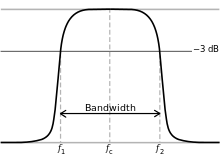Figure of merit
The quality factor , also quality , circuit quality , filter quality , oscillating circuit quality , sharpness of resonance , or Q-factor , called in the art is a measure of the attenuation and the energy loss of a to vibrations enabled system (e.g., as an oscillating circuit ). A system with high quality means that the system is weakly damped .
In a second meaning, the quality factor is an indicator for the energy loss of a two-pole electrical component or network .
The reciprocal of the quality factor is called the loss factor in both meanings .
Electrical oscillating circuit
definition
The quality factor of a resonant circuit at a given frequency is defined as
With
- the stored energy at the beginning of a period of oscillation
- the energy that is converted into thermal energy within this period.
A quality factor of 0.5, or a degree of damping of 1 or a loss factor of 2, corresponds to the aperiodic limit case in which there is no longer any oscillation. A high quality therefore requires well over 0.5.
Series connection
In a series resonant circuit , an electrical resistor , a coil of inductance and a capacitor of capacitance are traversed by the same sinusoidal current with the rms value and the amplitude . The resonance frequency of the ideal resonant circuit and the real series resonant circuit is
with the resonance circular frequency . The period is . Inserted into the definition of results
The differential equation of the series resonant circuit is (see main article )
with the degree of damping . After division by , a coefficient comparison is performed
- ,
and one arrives at a relationship between the degree of damping and the quality factor
- .
Parallel connection
By analogy, is located in a parallel resonant circuit at the same sinusoidal voltage of (peak value , RMS ). In the real parallel resonant circuit, the resonance frequency is slightly lower than . The difference can be ignored for the calculation of the thermal energy that is emitted in the period.
Bandwidth

The quality factor of a resonance circuit is a measure of the sharpness of the resonance. This is expressed by the 3 dB bandwidth B :
with the resulting quality factor:
The upper limit frequency and the lower limit frequency are those frequencies at which the voltage or the current decrease to times the value of the maximum value. At this point the power in the resonant circuit is only half as great as at the resonance frequency of the lossless resonant circuit. When the level is represented as a function of the frequency , the bandwidth is the same as the frequency range at the limits of which the power root magnitude decreases by 3 dB . The cutoff frequencies can be calculated from
- and .
They are connected to the resonance frequency of the ideal oscillating circuit through
- .
Mechanical oscillating circuit
In mechanics , a spring pendulum (mass-spring system) is based on the differential equations
- .
with the deflection from the rest position, the mass , the damping constants preferably determined by friction , the spring constants , the degree of damping and the natural angular frequency of the undamped system.
The same definition of the quality factor as for the electrical oscillating circuit leads to
with the slightly reduced natural angular frequency of the weakly damped system
Electrical component
The quality factor of a linear, radiation-free two-pole network element or network with sinusoidal processes is defined as the ratio of the amounts of reactive power and active power or, equivalently, as the ratio of the amounts of reactance and active resistance .
- .
The quality factor is a measure of - usually undesirable - losses, particularly in a capacitor or a coil. For example, the coil quality
This equation is similar to the corresponding equation for the series resonant circuit, but applies to any frequency and not to a (non-existent) resonance frequency . A high coil quality is required if a low bandwidth is sought in an oscillating circuit.
The quality factor for network (elements) is also the cotangent of the loss angle .
Examples
The following table shows some orders of magnitude of quality factors for various vibrating systems.
| system | Quality factor Q |
|---|---|
| Aperiodic borderline case | |
| Electrodynamic loudspeaker | Type. |
| Electrical oscillating circuit | |
| Pendulum clock | |
| Vibration absorber | |
| Quartz crystal 10 MHz | |
| Frequency stabilized laser | |
| Superconducting cavity resonator | |
| Cesium atomic clock | |
| Mössbauer effect with gamma radiation |
literature
- Bernd Girod, Rudolf Rabenstein, Alexander Stenger: Introduction to systems theory . 4th edition. Teubner, Wiesbaden 2007, ISBN 978-3-8351-0176-0 .
Web links
- Conversion: 'bandwidth in octaves' N in quality factor Q and quality factor Q in 'bandwidth in octaves' N
- Q-factor and center frequency - find the cut-off frequencies (bandwidth)
- Quality factor Q in “bandwidth in octaves” N - and back - Excel
Individual evidence
- ↑ a b c International Electrotechnical Dictionary - IEV 151-15-46
- ↑ a b c International Electrotechnical Dictionary - IEV 151-15-45
- ↑ International Electrotechnical Dictionary - IEV 151-15-47
- ^ A b Erwin Böhmer, Dietmar Ehrhardt, Wolfgang Oberschelp: Elements of applied electronics: Compendium for training and occupation. 16th edition. Vieweg + Teubner, 2010, p. 69
- ^ Dieter Meschede (Ed.), Christian Gerthsen: Gerthsen Physik. 21st edition. Springer, 2013, p. 150f
- ^ Alan M. Portis, Hugh D. Young: Physics in the experiment. Vieweg, 1978, p. 34
- ↑ International Electrotechnical Dictionary - IEV 151-15-48
































































